The hidden test that anyone with a Windows computer should take

Although this is not very normal, sometimes RAM gives us problems and checking what this specific component is is not intuitive.
We will always tend, because it is the most natural thing, to think that what is not going well inside the computer is due to a software problem more than a problem caused by some hardware component and less by the random access memory (RAM).
But if we have a persistent problem no matter what you do, you can check the health of the RAM in the way we will see in this article. This way you will remove doubts.
- What is RAM and what is its purpose?
There's no point in fixing something we don't know exactly what it is and what it's for, so the first thing is to understand the purpose of RAM.
RAM is the main memory of the computer in which all the program data we are using at that particular moment is temporarily stored. This type of memory is not limited to computers, but also tablets, smartphones, smart watches and even televisions.
There are two aspects to this memory that others do not have, such as its tremendous operating speed and that it is volatile, meaning that it is emptied every time you turn off the device and everything stored in it is lost.
Random Access Memory (RAM) is what is used to manage everything that happens while your computer is running, and as you can see, the more RAM you have, the better the performance, as more data can be held and at a faster rate.
- How to tell if your RAM has problems
There are some symptoms that may appear on our devices that may indicate that the RAM is not working properly and it is advisable to check them. They could be things like:
- When the computer starts up we hear a few beeps.
- The computer is slowly slowing down while running.
- The computer crashes without any kind of software problem.
- If we go to the information on our Windows computer, we will see that it does not tell us all the RAM we actually have.
We can perform a RAM check using Windows, although it is not very in-depth, it can be a solution to know if the RAM in your computer is working well or if there is a problem. The way to do this is as follows:
- Press Windows key + R.
- In the window that appears, we must type mdsched.exe and then click OK.
- We restart the computer.
- When restarting, we press F1 and then choose between basic, standard, or extended tests, knowing that the time it takes is longer the more intensive each test is.
- Windows will restart automatically, and when finished, it will send us a notification telling us if it found errors in the RAM.
It might be a good idea to run a test of this kind, when you have a performance problem and you can't find the cause, since as we've already seen, RAM is the last or least thing one would imagine could cause problems.


.jpg)
.jpg)